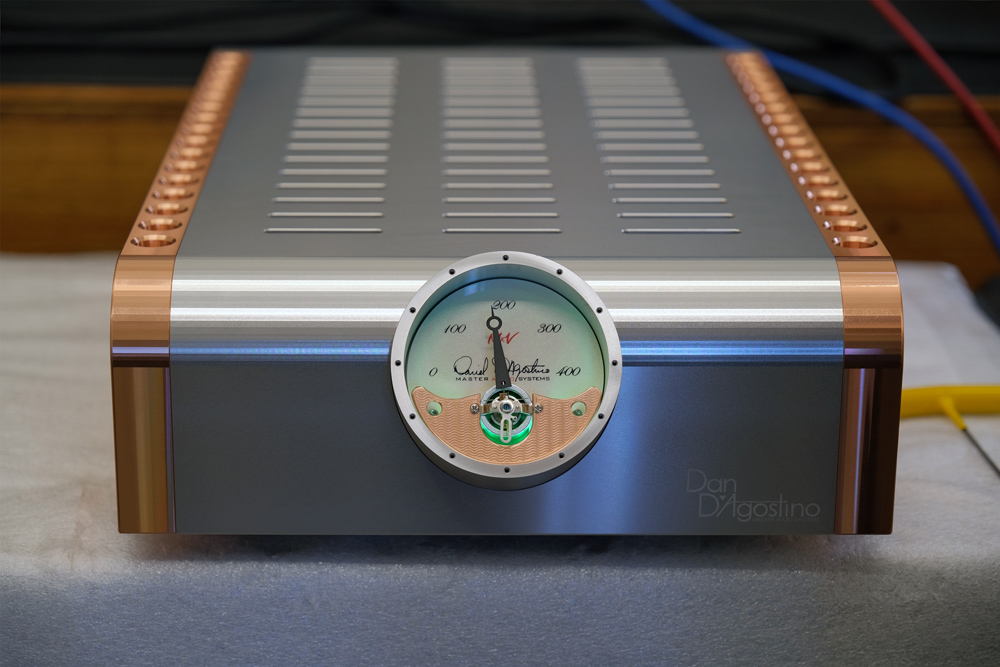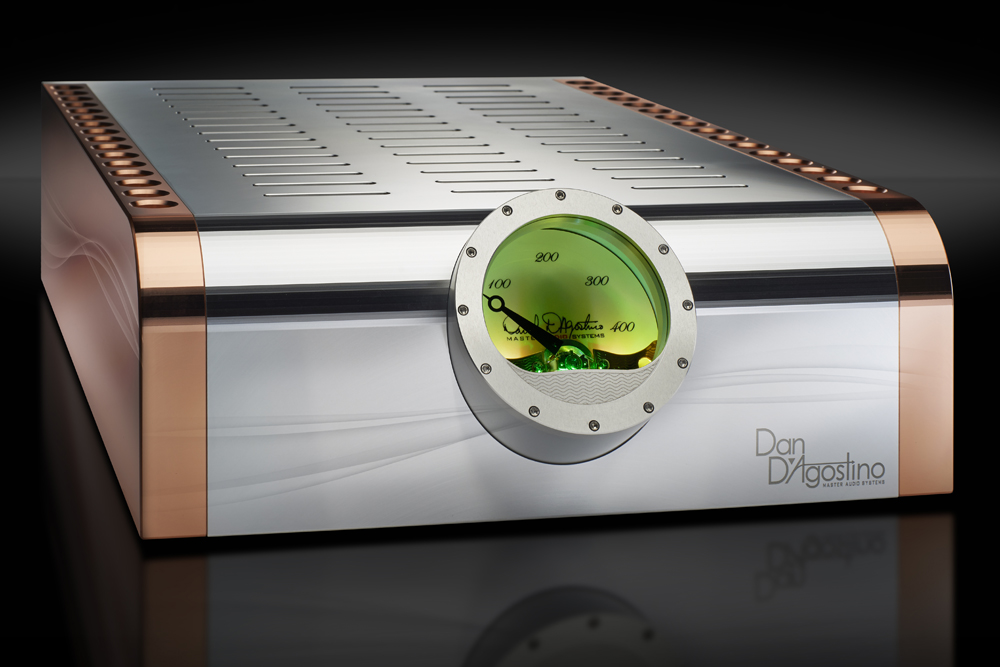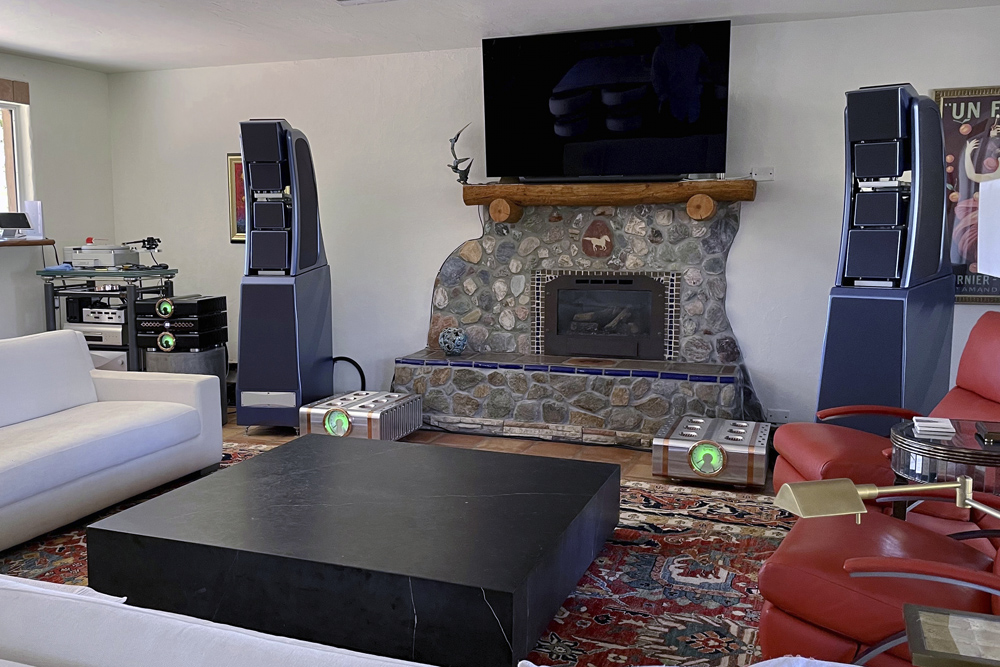Who would have thought cacti could be considered beautiful? The prickly mono-tone plants are hardly… aesthetically pleasing. But to my eyes, there’s an alien-like beauty in the impenetrably thorny forms. They’re… peculiar. Yet, despite their pin-pointed armour, the poetic paradox is that they offer lifesaving, fluid-filled fleshy stems. They’re everywhere across the North American west. Legions of them, reflecting across the windscreen on the drive to Pheonix, across Arizona’s parched landscape. I’m on a… relentless (yes, fully intended) mission to once again meet-up with the man himself. Dan The Man. At the Dan D’Agostino Master Audio Systems facility in Cave Creek out beyond the sparse Phoenix outskirts.
Giddy Up!
This second stage of the USA adventure (stage one was the visit to Wilson Audio, feature here) begins by jumping in an open-topped Mustang at Phoenix airport. Excellent choice from Advance Audio Australia’s Nigel Ng, designated driver. Me… I’m riding shotgun. Genuine American style V8 road trip here, minus the saddle sores.
From the airport, prior to D’Agostino, we spin it like dust devils to Sedona, a beautiful archetypically-styled small town blending modern with Old West and Navajo architecture. Sedona is encircled by canyons and rocky escarpments – all picture-perfect. From there we hot-wheel it back to Phoenix for a dinner date with Dan, wife Petra (company CEO) and Global Sales head Alex Wilde and partner prior to the factory visit the following morning.
An early morning start has us arriving at Dan D’Agostino Master Audio Systems (DDMAS) at Cave Creek. We’re greeted by Alex Wilde head of Global Sales, our guide through the facility. Inside, we see Dan D’Agostino and engineer Burhan Coskun, exchange pleasantries and arrange my video interview with D’Agostino after the factory tour (watch the video here). Greetings aside, we get straight into it.
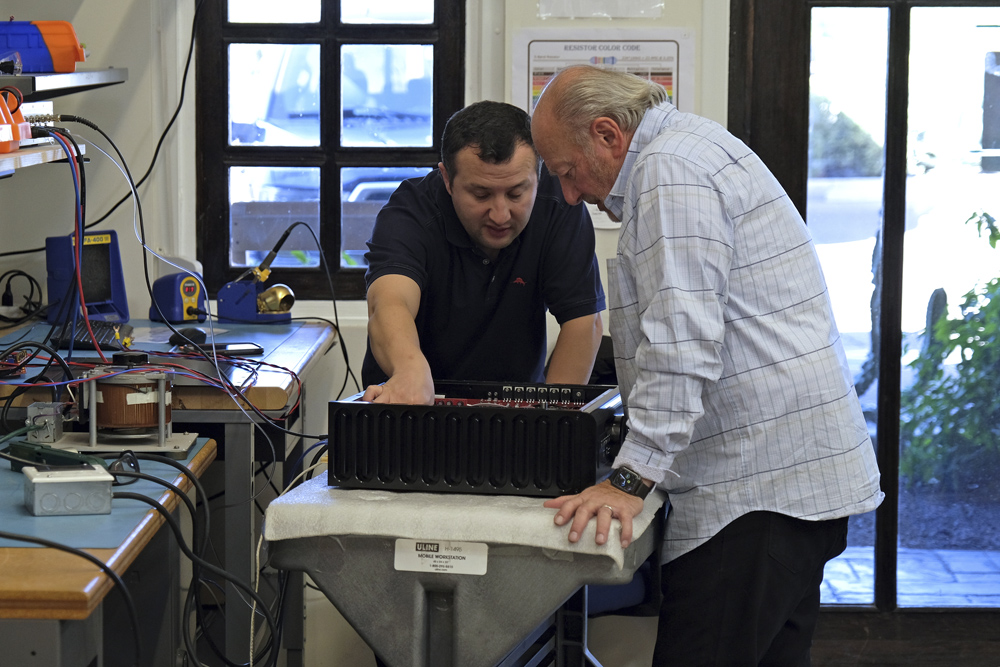 Dan D’Agostino examines an amplifier with engineer Burhan Coskun.
Dan D’Agostino examines an amplifier with engineer Burhan Coskun.
Wilde takes us to a section where a black-finished Relentless amplifier is in the final stages of assembly. He tells us that once all the design-based tests are performed, and prior to signing-off, the amplifier is run for up to 48 hours in order to confirm faultless operational behaviour. This is partly conducted in a small adjacent area in the context of an actual audio system consisting of a budget turntable, a TEAC/Esoteric CD player, a DDMAS amplifier, naturally, and a pair of Wilson Audio Sasha DAW. On standby, to the side, is a pair of Wilson Audio Alexx V.
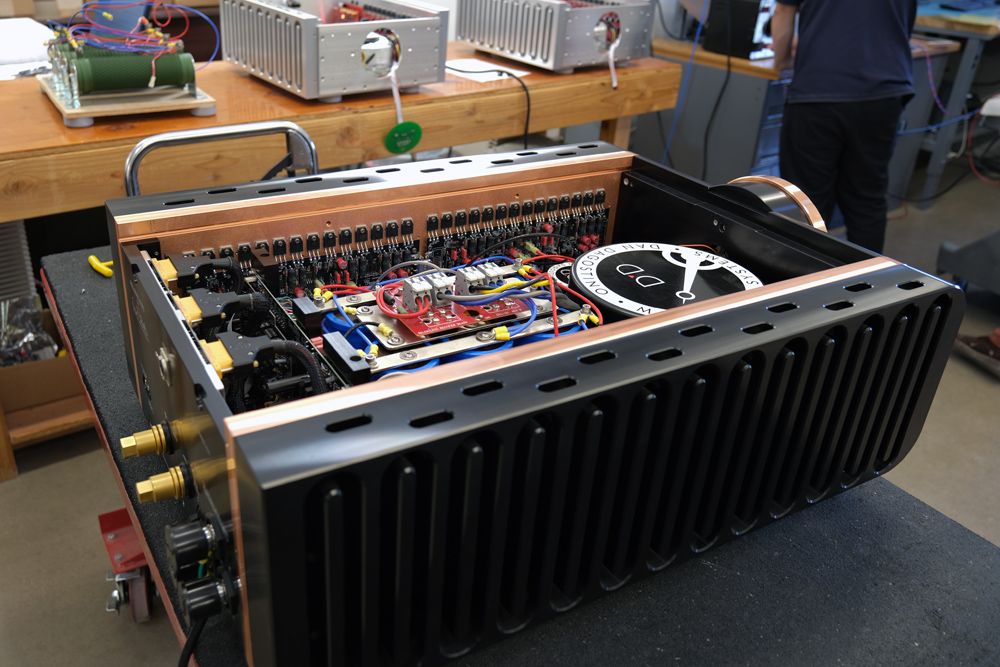
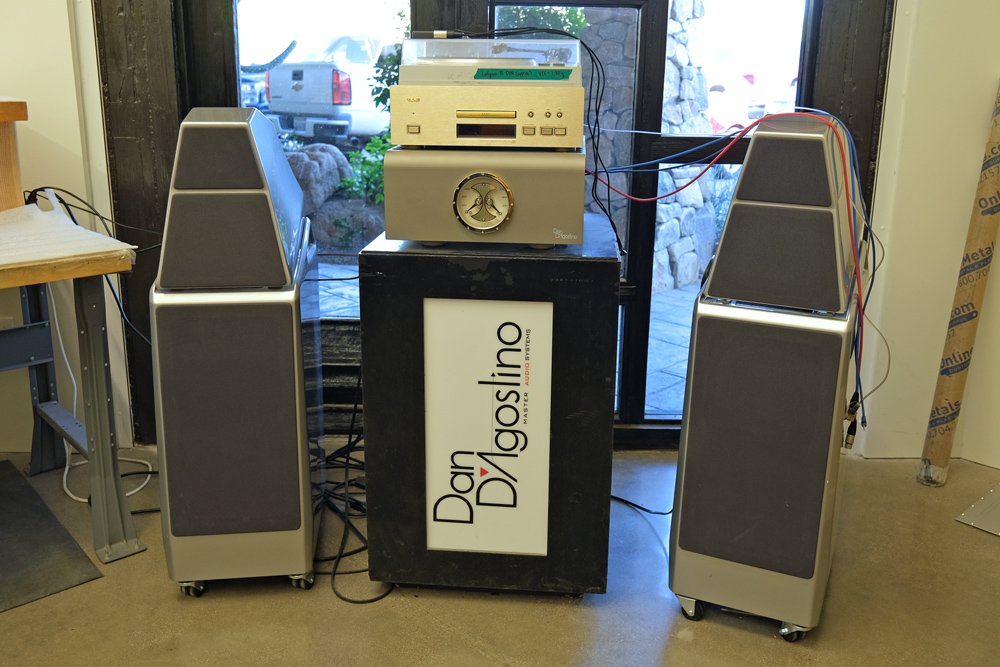
Next, I’m guided to an area where a technician is crimping wires along a bench lined-up with massive transformers. I ask where the transformer units are manufactured, “It would be too dirty for us to produce these transformers in-house, so we source them from a variety of suppliers in Asia and Mexico” Wilde tells me.
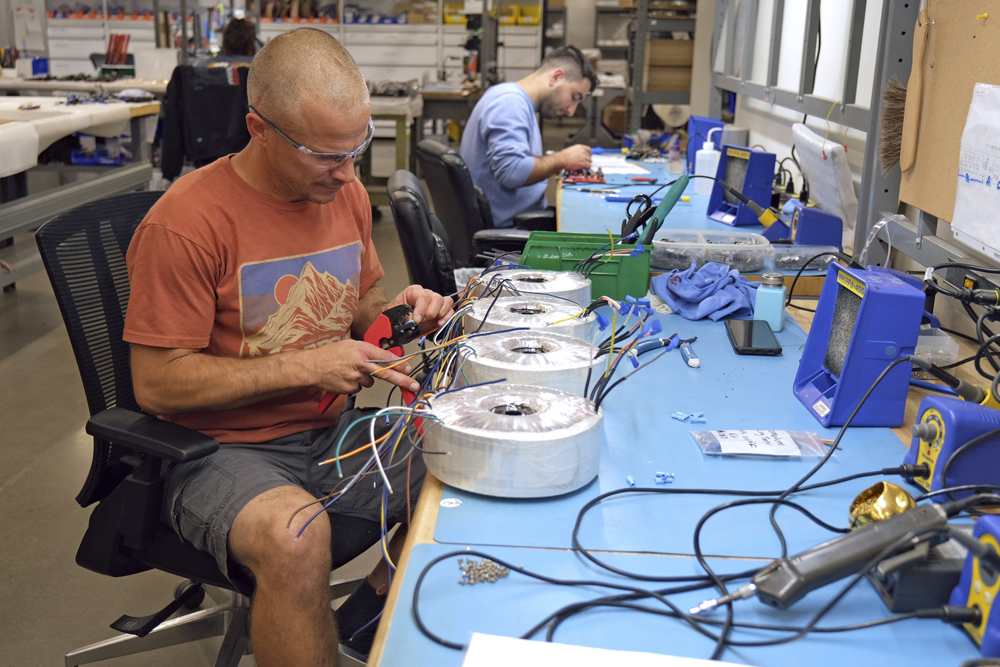 Steve crimping transformer wires.
Steve crimping transformer wires.
The transformer bench is flanked by a well-organised parts storage area where transistors, diodes and a host of electronic parts are stashed. “Stuffing” bins and charts are used here to allot, dispense and instruct the selection of parts required to populate the SMDs/boards by the appropriate technicians. The shelving is catalogued by product and groups the appropriate component values and types for correct circuit board assembly. Every circuit board is trimmed, checked for parts accuracy and thoroughly tested through the assembly process.
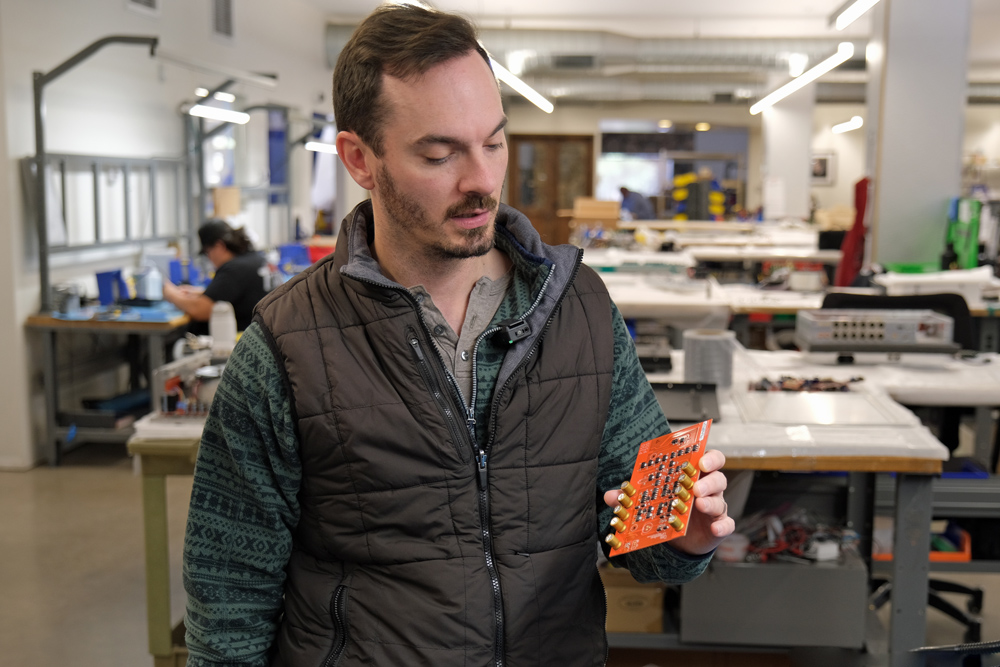 Alex Wilde shows a pre-population circuit board.
Alex Wilde shows a pre-population circuit board.
Wilde explains further, “Alpha boards for a Progression integrated are somewhat easier to put together but there are tough ones too… especially once we go into the Relentless production areas. It’s also a modular system where circuit boards can be tested individually and easily replaced if need be.” Of note, in its own dedicated separate room, the recently acquired Wave Soldering machine now handles a large proportion of the circuit board soldering.
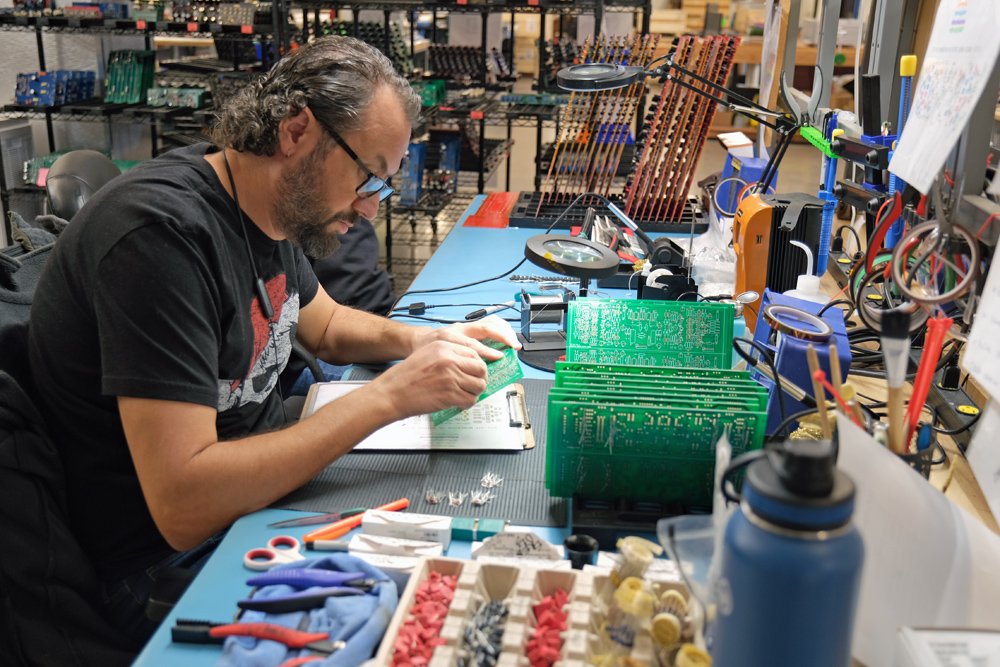
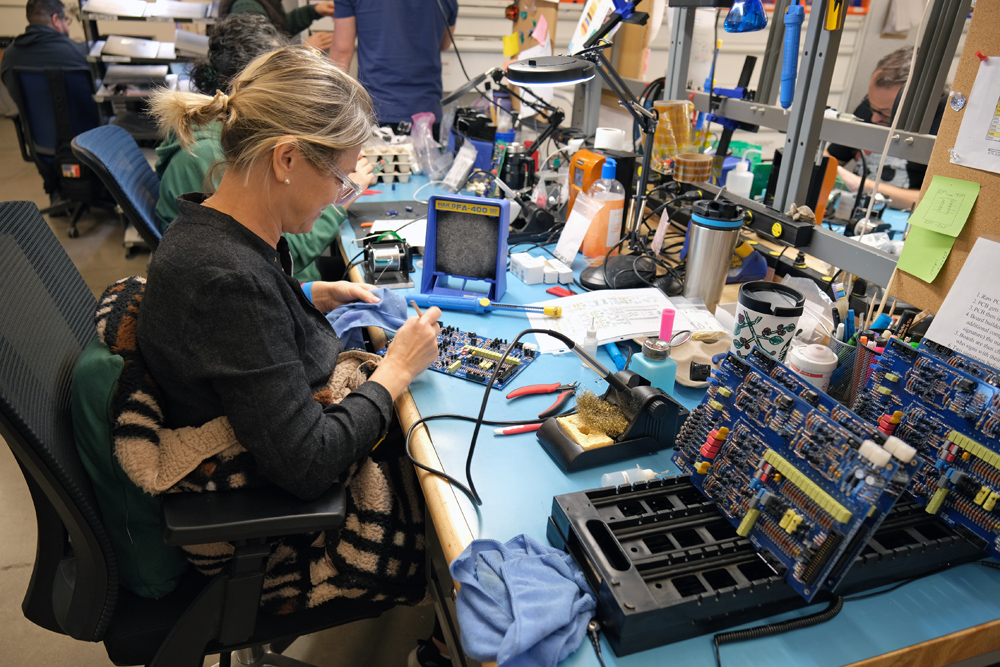
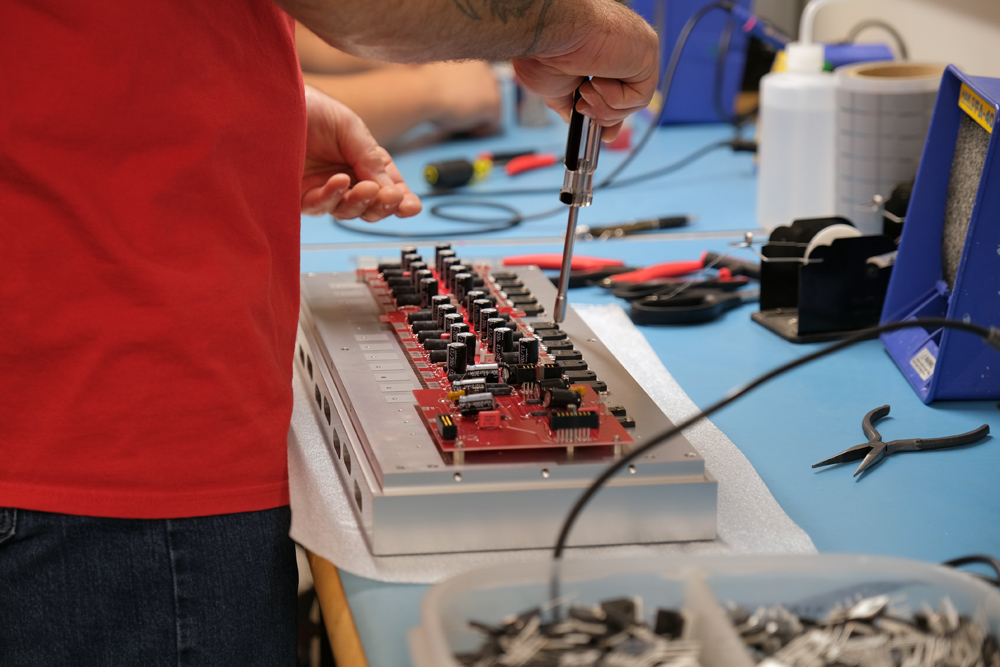
The shelving, storage and general parts inventory warehousing have been somewhat of an administration and logistics challenge. DDMAS has grown exponentially in a relatively short period of time. What’s more, the company has released new product lines and categories. This, in addition to the extensive resources demanded by parts-rich über high-end products such as the expanding Relentless line. This has presented storage issues and, aside from a physical expansion of the premises, factory floor and administration areas, the company has had to acquire two shipping containers for further storage applications.

The above issue is irrespective of the supply chain problems the entire electronics, automotive and other high-end industries are undergoing currently. The factory shut-downs in China and the global chip shortages have compounded the problem. Wilde tells me, “Some parts, like capacitors, are custom made for us from established high quality suppliers and we have had no problems there. But with other components, we’ve had delays of more than 52 weeks for some parts for our Progression integrated DAC. Sometimes beyond that.”
I got onto the subject of the metal parts sourcing, in light of the extraordinary quality and machining complexities of the DDMAS products in general, but in particular the superb chassis standards of the Momentum and Relentless lines. “Many of the Progression metal parts come locally from Mather and the Momentum parts come from a machine shop in Colorado.” Colorado, of course, has a standard-bearing reputation for being the aluminium chassis machining source for many highly respected high-end audio brands.
Moving around to a boundary section of the building landed us at a testing area where Gregory checks for circuit integrity and overall functionality while also level-calibrating and channel-matching the famous Breguet-style meters.
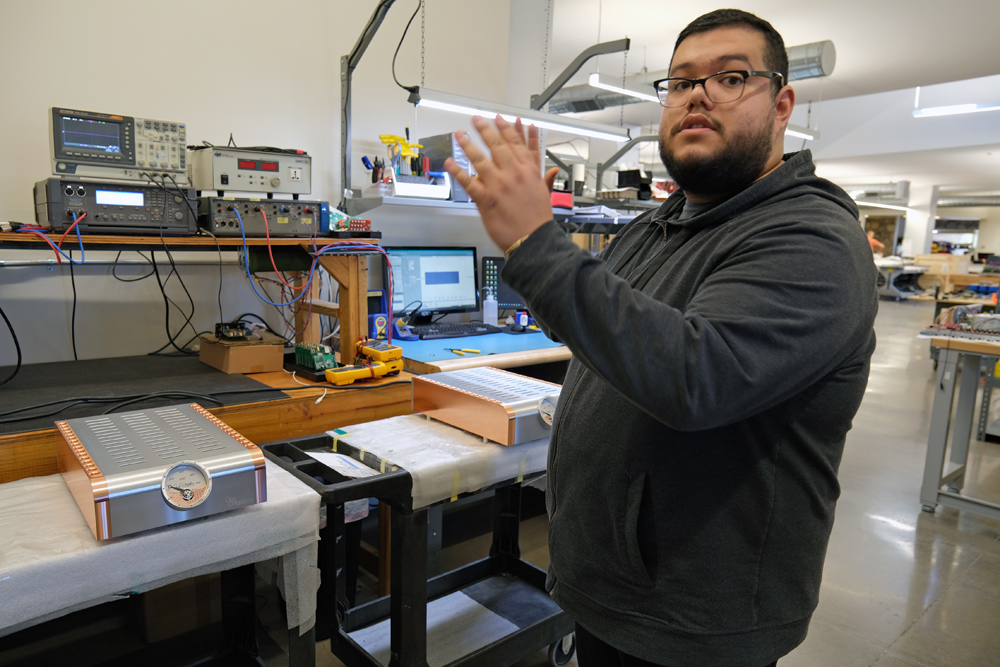
At this stage, Dan D’Agostino himself joins the tour and takes the guidance reigns. He starts-off by showing me a Relentless Epic 1600 monoblock in the process of being tested and finalised. It’s obvious he’s extremely proud of this major achievement in amplification design, “This is our flagship as you know. It’s been very popular. And it took us about a year to get it to work. It’s a very complicated thing and works on different principles than normal amplifiers.”
I ask D’Agostino what freedoms he has been able to enjoy since the days of Krell, “Total freedom. There’s no resemblance between now and then. Here I’m looking for the maximum information retrieval and the most musical. I’m less into the measurements like how little distortion, how much power, how fast the amplifiers are. Here, I’m interested in sound. We’re sound merchants. I’m only interested in sound. In the end, whatever I have to do to the circuit to make it sound right, I do it. Small differences in distortion, or other measurements… that’s not interesting to me. I’m only interested in the sound.”

I found that both refreshing and interesting, coming from the perspective of an engineer. D’Agostino is no longer chasing the endless tail of measured perfection – he is aiming for his take in ultimate sound quality. He reinforces this with a further clarification, “These amplifiers measure very well. I can maybe make them to measure even better. But they’ll sound worse. By the way, the first DDMAS amplifiers were the hardest things I’ve ever designed. I wanted massive power supplies to fit into a small chassis, which had to be beautiful, room friendly and sound right.”
To take the concept of sound quality even further, D’Agostino plans to add another extension to the facility. This new area would house new administration offices and a purpose-built listening room. A room-within-a-room type of structure with thoughtful acoustic treatment. “This will be a great tool,” states D’Agostino, “a room that’s dedicated to sound, with the right dimensions, beams on the ceiling, etc.”
An R&D area reveals the new Momentum Integrated amplifier in its development stages. While the main circuitry is yet to be fitted, the chassis, to me, seems to be just about finalised barring the ubiquitous trademark meter. A thing of beauty.
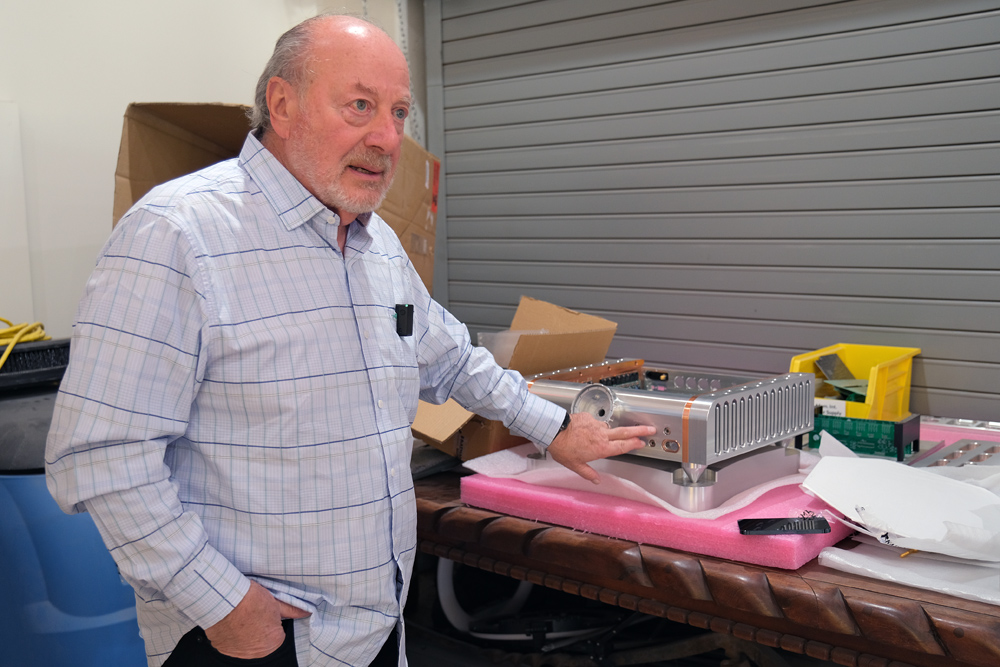
“It’s a complete redesign from the original”, D’Agostino tells me, going on to say, “it’ll have a very high quality DAC and streamer in it; it’s a whole rethink. It’ll have a Momentum HD preamp and a Momentum MxV amplifier in one box. It has a pretty decent headphone amplifier, which I resisted, but Burhan [senior Engineer] did a nice design to make a little window so we don’t have an ugly jack on the front plate. A big power supply, 2000VA transformer, the heatsink design of Relentless… a tour-de-force, a pretty awesome product. The sound that this is going to produce will be extraordinary… really extraordinary. I can see this with an Alexx V and you’re in Rock heaven” D’Agostino affirms with a smile.
“We’re aiming for a big reveal in Munich 2023. As a company, you have to keep bringing new things or improving them. The Momentum is probably the longest running amplifier in the high-end. It keeps going because we keep making it better.”
I ask D’Agostino how the design process starts. Does he dream-up a circuit and then passes that on to other engineers to refine or does he take the concept all the way himself. “I facilitate the designs. I may think of a circuit I might want to use, like I did with our last product the Relentless preamplifier, then we go about adding values to it. After that, we go to layout where they’ll listen to it and it gets worked from there. Along the way, some of the things we added to the circuit got massaged by engineers Burhan and Hassan, and they might suggest to change something and I’ll say great, let’s do that. Let’s make it better.”
D’Agostino further clarifies, “It’s an evolutionary process and the sky’s the limit. Except for the Progression integrated, our entry product, we don’t design to a price point, we don’t have that barrier or an economy. It comes out the way it comes out. Like the Relentless amplifier… the sky’s the limit.”
Journey Through a Desert
The final stage of my Phoenix visit has me floored. Dan has invited me to spend some time at his home for a listening session. Spending one-on-one time with ‘The Man’ discussing music and experiencing the great pleasures of his awe-inspiring home system trumps any factory visit.
D’Agostino’s mode of transport is a gigantic late model American-style pick-up truck. Climbing (literally) on-board and driving the short distance to his desert-bordering home is an experience in itself, even for a bloke like me who lives outside Sydney’s over-reaching metro area. I’m already high due to what awaits at Dan’s home… the truck ride feels like I’m flying.
There’s endless Arizona wilderness, a dryness, which the thorny, coarse flora accentuates. We roll into a narrowing drive, around a cactus-flanked roundabout which then opens out, revealing a sprawling single level home – I'm chez D’Agostino.
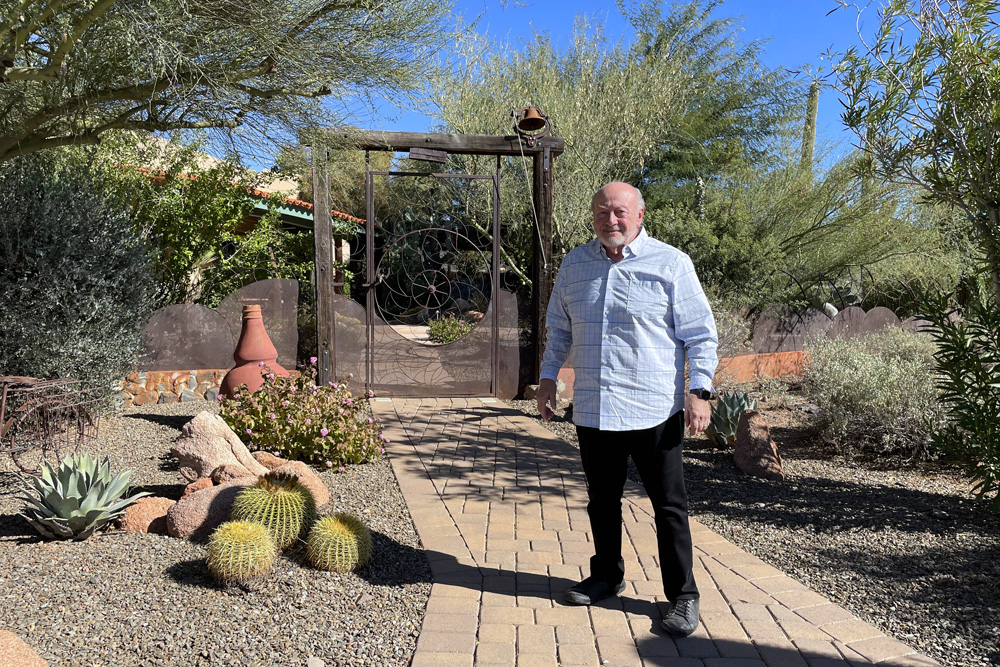
The main lounge room houses the jaw-dropping audio system. DDMAS Relentless Epic 1600 monoblock amplifiers driven via the first-ever produced Relentless Preamplifier, a stunning 3-box mammoth complete with its bespoke digital module. Sources were a TechDAS turntable hooked to a prototype DDMAS phono stage, Denon CD player as transport and a dCS DAC (I’d assume for comparison purposes to the Relentless Preamplifier’s own). Cable is Transparent and power is kept clean via Stromtank. The loudspeakers are the mighty Wilson Audio Chronosonic XVX.
D’Agostino streamed a wide, and wisely-chosen, selection of music from Jazz to Rock and Classical/Orchestral. Each piece demonstrated to full effect the powers of this remarkable assembly of SOTA products.
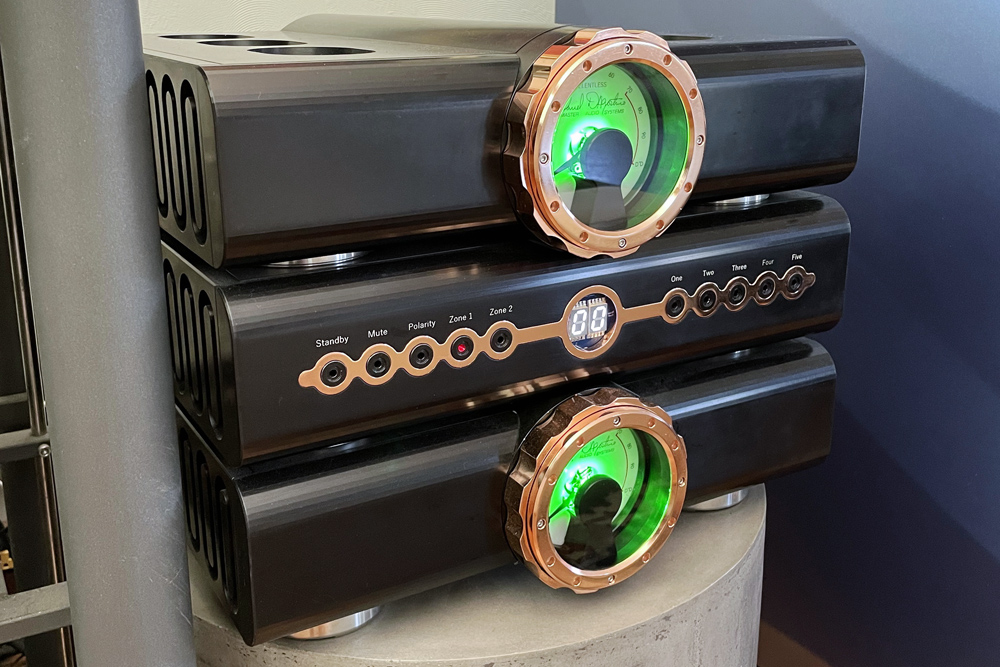
I was astounded at the purity and presence of Ella and Armstrong, at the power and control of the low frequencies on Chris Jones’ staple “No Sanctuary Here”, the tight dynamics on Boz Scagg’s “Thanks to You” and the beautiful tonal qualities of Ahmad Jamal’s piano on “It could Happen to You”. Ditto for one of Dan’s favourite recordings, Keith Jarrett & Charlie Haden’s “Everything Happens to Me”. I enjoyed Dan’s commentary and pertinent anecdotal titbits, both of a personal and general nature, which sprinkled some spice and imparted a deeper interest to each track.
D'Agostino also shared some history. His father was an audio enthusiast who owned a simple Lafayette Radio system and built his own Klipschorn speakers. Along with that, back in his school days, D’Agostino had a teacher/mentor who introduced him to amplifier circuits and simple tube amps. Then, D’Agostino Senior bought a Lafeyette Radio pre/power amplifier. That was a “Wow!” moment for young Dan.
“I then discovered Wireless World magazine and read about the Williamson push-pull amplifier. At the bottom of the article there was a schematic. So I went to my electronics teacher, who happened to be a frustrated engineer, and he explained to me how it all worked. The schematics had a list of components so you could buy what you needed to build it. In those days there were lots of discount stores and surplus stores and I’d go in there and find an output transformer, capacitors and tube sockets and chassis.”
D’Agostino continued, “So he would work with me during class and we’d put amplifiers together, introduced new concepts to improve things and bounced ideas off each other. And he’d show me how to bias the tubes and how it all worked. I had a rudimentary understanding back then. My first amplifier, I brought it to school, and he checked it all, made sure all was working, measured everything. Then I brought the thing home and put it in place of my father’s Lafeyette Radio and it was so much better. You could hear it instantly. I really was hooked on audio from that time on.”
Conclusion
On this last leg of the American trip which started days earlier in Salt Lake City to then hit Phoenix, I gathered deeper insights into the complex world of high-end audio manufacturing. The first, from a very mature company and one of the leaders in loudspeaker design. The second, from a relatively young company, led by an industry legend in Dan D’Agostino. DDMAS has taken the slippery über high-end bull by the horns, achieving remarkable growth and deep market penetration through its superbly designed products far removed from the main designer’s former glories.
Dan D’Agostino Master Audio Systems has reached the dozen since its inception in 2011. It is consistently challenging its capabilities by creating products of outstanding merit, and importance, to the high-end space. Yes, you could say D’Agostino has pushed for supremacy with uncompromising, forceful… momentum.
Once again, it’s that change in direction Dan D’Agostino emphasised during our talks, “Music is the driving factor now. It gives you so many things to think about, it changes your mood and your ideas. That’s a great thing. And if you can make that more fun by what you do, then that’s even better.”
I hear you Dan…
… Edgar Kramer
This email address is being protected from spambots. You need JavaScript enabled to view it.
Dan D’Agostino Master Audio Systems
Australian Distributor: Advance Audio Australia
+61 2 9561 0799
www.advanceaudio.com.au
Dan D’Agostino Master Audio Systems
5855 E Surrey Drive, Cave Creek
Arizona 85337
United States of America
1 (480) 575 3069
www.dandagostino.com






